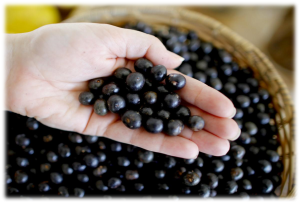
What Is Acai?
Acai – sometimes written as açaí – is an inch-long, reddish-purple berry that comes from a South American palm tree. While acai is relatively new to North American and European markets, Indigenous tribes of the Amazon region have eaten it for centuries. Some companies have marketed acai berries as a superfood that can help reverse aging and aid with weight loss. But do they live up to the hype?
There’s no formal medical definition of a superfood. But the term generally refers to a food that’s high in healthy nutrients like fiber or antioxidants. Acai seems to fit the bill, since studies show that acai fruit pulp is even richer in antioxidants than cranberries, raspberries, blackberries, strawberries, or blueberries. Acai, pronounced ah-SI-ee, also contains fiber as well as other vitamins and minerals.
 As in all Super Food or medicinal plants there’s little scientific evidence, though, that they actually promote medical benefits.
As in all Super Food or medicinal plants there’s little scientific evidence, though, that they actually promote medical benefits.
Health Benefits of Acai
Some studies have found that acai berries or acai juice:
May protect against free radicals
Free radicals lead to a process called oxidation, which damages cells. Experts believe cell oxidation may be a leading cause of diseases like cancer, heart disease, and diabetes. But we need more research into whether antioxidants could lower the risk of these illnesses.
Acai’s purple color comes from the antioxidant anthocyanin. Early studies have shown that anthocyanins protect cells from oxidation damage. But we need further studies into its effects in humans and how much acai you might need to get this effect.
Early research shows that eating or drinking acai may help lower LDL – or “bad” – cholesterol levels. Too much LDL cholesterol in your body can lead to the buildup of a substance called plaque in your arteries. This causes blockages that could result in heart disease or a stroke.
May help manage blood sugar
One study found that overweight people who ate or drank acai pulp for 30 days were better able to manage their blood sugar. Carrying extra weight increases your risk of having high blood sugar levels and getting type 2 diabetes.
We need more research into whether acai can help with blood sugar management, and what the right dosage of acai might be.
Why is acai used in beauty products?
Some cosmetics and other beauty products include acai oil because antioxidants are thought to help protect your skin against the damaging effects of free radicals. There’s little research into this, though.
- Facial and body creams
- Anti-aging skin therapies
- Shampoos and conditioners
Can Acai Berries Boost Weight Loss?
Marketers’ claims that acai products promote rapid weight loss are unproven. In fact, early studies show that acai has no effect on weight at all.
While berries and other fruits add healthful nutrients to your diet, the jury’s still out on whether there’s something about acai that promotes weight loss.
In 2013, the Federal Trade Commission (FTC) ordered certain online marketers of acai products for weight loss to pay $9.4 million in fines and settlements for misleading claims.
If you need help with weight loss, contact a doctor, nutritionist, or another specialist in this area.
Acai Nutrition
There’s not a lot of official information about the nutritional value of acai, which is mostly sold in the U.S. as a frozen puree. For exact nutrition information, read the label of the acai product you’re eating or drinkin
According to the FDA, a 2-ounce serving of acai puree has:
- 60 calories
- 3 grams of fiber
- 2 grams of protein
- 5 grams of fat
- 6 grams of carbohydrates
- 40 milligrams of calcium
- 1,000 international units (IU) of vitamin A
- 9.6 milligrams of vitamin C
- 60 milligrams of potassium
Things to watch out for:
Acai is generally safe to eat as a fruit pulp in smoothies and acai bowls. But drinking pure, unprocessed, acai juice may lead to Chagas disease. This happens when a parasite from rural areas in Central and South America infects the fruit. Some people who get this disease never have symptoms.
How to Eat Acai
Two popular ways to use acai are in a smoothie or acai bowl. Both require blending frozen acai pulp or acai berry sorbet with other ingredients of your choice.
You can also find acai in many supplements, in powder, tablet, or capsule form.
Acai bowl: How to make your own
Ingredients:
- 8-ounce packet unsweetened frozen acai puree
- 1 mediumbanana
- ½ cupblueberries
- 1 tablespoonhoney
- 3 tablespoons granola
- 1 tablespoon unsweetened coconut flakes
- ½ cupnonfat Greek yogurt
Instructions:
- Pour water on the frozen acai puree for a few seconds to break it up.
- Mix in a blender: the acai berry puree, half the banana, ¼ cup of the blueberries, the yogurt, and the honey.
- Stop the blender and stir it from time to time until you have the thickness you want.
- Pour into a bowl.
- Use the rest of the fruit, the granola, and the coconut as toppings for your bowl.
Side Effects of Acai
If you have pollen allergies or are sensitive to acai or similar berries, you may want to avoid this fruit. If you eat it in moderate amounts, though, acai is likely safe for most people.
Don’t eat or drink acai if you’re scheduled to get an MRI, since it could interfere with the test results..
Interactions
If you take any medication regularly, talk to your doctor before you start acai supplements. They could interact with over-the-counter drugs like ibuprofen and other NSAID painkillers, as well as prescription drugs for pain.
If you take cancer drugs, check with your doctor before taking an acai supplement. Acai could make the effects of these drugs weaker. Don’t use acai along with other antioxidant supplements unless your doctor says it’s OK.
Doctors don’t recommend acai supplements for children or for those who are pregnant or breastfeeding.


